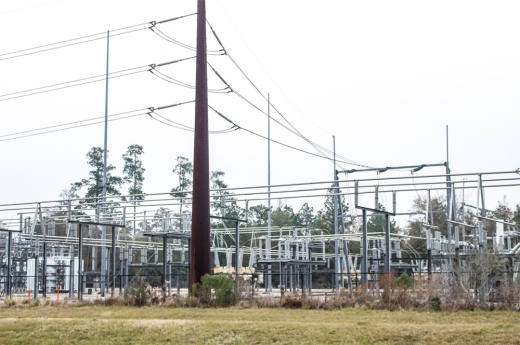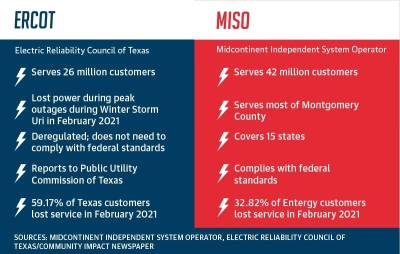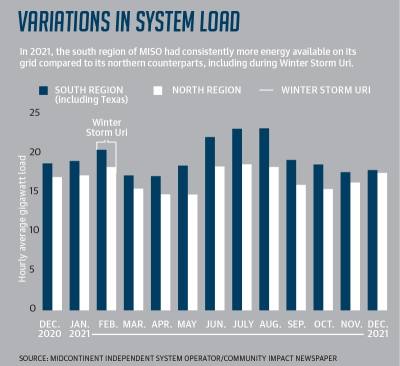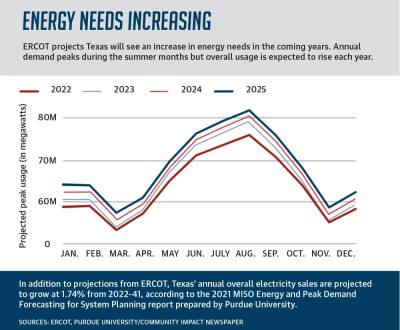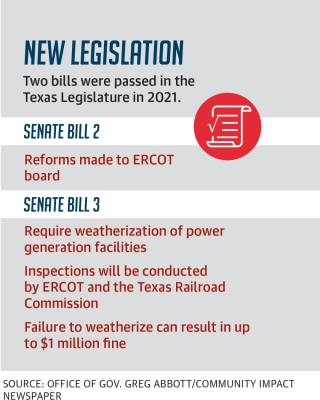Approaching the anniversary of Winter Storm Uri in mid-February, local energy provider Entergy announced its winterization efforts were completed before its 2023 deadline and are ready for cold weather this year.
Improvements throughout 2021 included insulating critical equipment and pipes that could be at risk of freezing, Entergy Customer Service Manager Detrick Taylor said at a Dec. 8 meeting of The Woodlands Township board of directors. Additional energy reliability efforts will continue through 2022, he said.
The first test for recent improvements came during below-freezing temperatures in early February this year, in which Entergy officials said only 90 customers lost power in The Woodlands area, 85 of which were due to equipment failure, and power was restored within 35 minutes.
Chris Nunes, assistant general manager in The Woodlands Township, said electrical systems have been operational in recent cold weather.
“We discussed with our electrical partners and we were not notified of any significant outages during the last storm,” he said. “[Our electrical partners] were making various repairs ... and they addressed those prior to the storm.”
However, energy experts said the February temperatures were not as severe or sustained as the deep freeze that caused disruptions last year, including widespread outages in the Electric Reliability Council of Texas, or ERCOT, grid that also serves The Woodlands area in Creekside Park.
“This was run-of-the-mill winter weather,” said Ed Hirs, energy economics professor at the University of Houston.
Winter preparation efforts
According to Allison Payne, senior communications specialist with Entergy, winterization efforts began following Winter Storm Uri in February 2021.
Previous reporting from Community Impact Newspaper indicates at the peak of the storm, 155,238 Entergy customers out of the 473,000 in Texas were affected by outages.
“Immediately following the storm, we began a thorough post-event review of what happened and identified areas for improvement,” Payne said in a Jan. 28 email. “Through this process we developed and enhanced plant-specific processes and procedures and identified projects to upgrade and harden our plant freeze protection systems.”
Entergy is part of the Midcontinent Independent System Operator network, meaning it is part of the national energy grid, as opposed to the deregulated ERCOT grid. Because of this, Entergy follows federal guidelines for weatherization. The North American Electric Reliability Corporation, a regulatory authority tasked with reducing reliability risks across most of the continent, is requiring its winter readiness recommendations be implemented by April 2023, Payne said.
During the Dec. 8 board meeting in The Woodlands, Taylor and Jace Carlock, manager of distribution reliability for Entergy, said insulation efforts at power plants had been the primary focus for winterization, but Entergy also replaced 35,000 feet of underground cables, 200 transformers and six switch cabinets across The Woodlands as part of a general reliability update for the area.
Most of the work was done in the Panther Creek Village, Carlock said, and plans for 2022 in The Woodlands area include an additional 50,000 feet of cable replacement, 200 transformers and 34 switch cabinets.
Entergy officials said as of Feb. 9 they were unable to estimate the total cost of the improvements made to its system.
Assessing the grids
Following Uri, ERCOT developed a plan in July to improve reliability called its Roadmap to Improving Grid Reliability. As of a Jan. 7 update, it highlighted 60 projects it has been working on since the 2021 winter storm, which include communications, site assessments and board reorganization. Nine were on track for completion, one was marked as having “limited progress” and the others were listed as complete.
Two of the on-track projects involve working with the Public Utility Commission of Texas to implement Senate Bill 2, which reorganized ERCOT, and SB 3, which put guidelines in place to strengthen weather preparedness. The two bills were passed by Texas Legislature in 2021 and signed into law.In addition, according to a Jan. 12 news release from ERCOT, 324 on-site inspections had been completed for weatherization as of that time. Of the 324 inspections, 299 generation units and 22 transmission facilities passed the guidelines from the Public Utility Commission of Texas with three generation units still having deficiencies.
The release from ERCOT stated the Texas Legislature increased the maximum penalties for ERCOT energy companies violating weatherization rules to $1 million per day per violation. However, Hirs said there are still concerns regarding the grid. For example, a January report prepared by Hirs and the University of Houston noted that the bills still give the Public Utility Commission of Texas “wide discretion” to implement the law.
“The underlying model behind the ERCOT market has not been changed,” Hirs said. “The mandates to weatherize are essentially unfunded mandates. We will not know how successful the operators are until the system gets tested by another freeze.”
Hirs said around 20% of the energy plants reporting to the PUCT were not going to weatherize either because they would not or could not.
“They are all self-reporting,” Hirs said. “ERCOT has inspected 323 plants and found that 321 of them met whatever threshold ERCOT had in mind to be weatherized. That leaves more than 400 that have not been inspected.”
Hirs added that according to his knowledge, ERCOT did not have black start units, which are used to get an energy grid going after a massive blackout.
ERCOT’s roadmap states it has endorsed PUCT to begin work on a black start improvement plan, but ERCOT could not be reached for comment as of Feb. 9 to verify the status or respond to Hirs’ claims.
However, after press time on Feb. 10 ERCOT officials replied, saying, "ERCOT Black Start plans have been in place for many decades and would be used if the grid needs to be restarted after a system-wide failure. While it has never been needed, ERCOT performs Black Start Training regularly to ensure familiarity with the process of restarting the grid."
Increasing energy demands
Gavin Dillingham, vice president of research for the Houston Advanced Research Center, said he believes the guidelines Entergy follows resulted in fewer people in its coverage area experiencing outages during Uri.
“Demand continues to grow with electrification of different sectors,” Dillingham said.
Dillingham said for the Houston region in particular, major factors leading to a greater demand on the energy grid are the rising population in the area and both warmer and colder weather.
“COVID[-19] slowed things down a little bit,” Dillingham said. “Consumption went down a bit, but it is coming right back up again.”
Information from a peak demand energy forecast from ERCOT indicates energy demands will rise. The forecasted peak for February is 59,429 megawatts, and by 2024 the same month is anticipated to peak at 63,254 megawatts.The anticipated peaks for energy are largely seen in the summer months of June through September, when peak energy needs are forecast between 72,356 and 71,902 megawatts, respectively, this year. By 2024, the highest peak for energy needs is forecasted to be at 80,190 megawatts, according to ERCOT.
Dillingham said there is now a greater focus for demand management systems and increasing energy efficiency systems.
According to Dillingham, a push for alternative energy sources, including wind and solar, is also likely to emerge within the next decade for the region.
“Demand is increasing with population growth, increasing temperatures and interests in electric vehicles,” Dillingham said.




